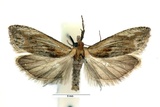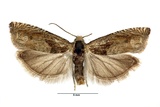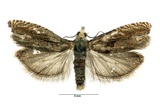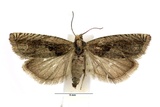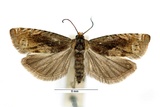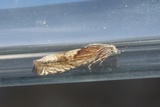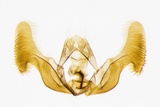Eucosma hohenwartiana ([Denis & Schiffermüller], 1775) Species
Last modified: Nov. 24, 2025, 5:05 p.m.
A rare species throughout Belgium.
Details
- Classification
- Family: Tortricidae > Subfamily: Olethreutinae > Tribus: Eucosmini > Genus: Eucosma > Species: Eucosma hohenwartiana
- Vernacular names
- Scherp knoopvlekje (NL), Bright Bell, Common Knapweed Tortrix (EN), Flockenblumen-Blütenwickler (DE)
- Synonyms
- Eucosma scopoliana sensu (Haworth, 1811) and Eucosma fulvana (Stephens, 1834)
- First mention in Belgium
- De Sélys-Longchamps E. 1844. Énumération des insectes Lépidoptères de la Belgique. — Mémoires de la Société royale des Sciences de Liége 2: 1–35. On page 21.
- Status
-
Native
Distribution
Imago
Wingspan 14–22 mm. Very variable in size and in in colour ranging from grey-white to white-ochreous, in suffusion with brown, which may obscure the medio-dorsal patch of light ground colour.
Distinguished from Eucosma cana by absence of the pale/white forewing streaks and generally darker ground colour, and from Eucosma obumbratana by the strongly developed costal strigulae in apical half of the forewing and again by the generally darker ground colour which is fulvous in Eucosma obumbratana.
Eucosma hohenwartiana, E. fulvana and E. parvulana form a complex of species that only can be distinguished on the female ovipositor.
Note that however, Eucosma fulvana is still controversial as independent species and is probably more a synonym of Eucosma hohenwartiana.
Genitalia
Male genitalia: sacculus straight ventrally; neck of valva short, slender, with almost perpendicular proximal edge; cucullus large, elongate, with long , slender ventral lobe.
The valva of E.hohenwartiana is distinguished from Eucosma cana by a longer cucullus with a well-developed lobe, a shorter less robust neck and a more angulate ventral margin to the sacculus; and from Eucosma obumbratana by the absence of a pulvinus (a pulvinus is "normally lacking in Eucosma cana and E.hohenwartiana" which implies that it may be present sometimes).
Caterpillar
The larvae have a pink-ocher to pink body and a light to medium brown head.
Bionomics
The larvae live in the flower heads and late pupate in the soil. The adults come to light.
Flight periods
The adults have been observed from mid-May towards mid-August. Most observations during June.
Observed on
- Host plant (species):
- Centaurea nigra
- Host plant (genera):
- Centaurea
The larvae feed on Centaurea nigra.
Habitat
It inhabits dry, open and grassy areas.
